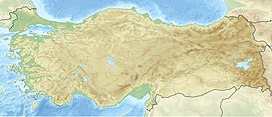Beşparmak Mountains
| Beşparmak Dağı | |
|---|---|
| Mount Latmus | |

Mount Latmus and the village of Kapıkırı
among the ruins of Heracleia, with Lake Bafa in foreground. View is to the north. |
|
| Highest point | |
| Elevation | 1,353 m (4,439 ft) at Tekerlek Tepesi, "the crest of the hub" |
| Coordinates | 37°29′53.19″N 27°31′36.51″E / 37.4981083°N 27.5268083°ECoordinates: 37°29′53.19″N 27°31′36.51″E / 37.4981083°N 27.5268083°E |
| Naming | |
| Translation | Five-finger mountain/range (Turkish language) |
| Geography | |
| Parent range | Beşparmak Dağlari at the southern edge of the Menderes Massif |
| Geology | |
| Mountain type | Ridge with multiple spurs, six major ones |
| Climbing | |
| Easiest route | Hike |
Beşparmak Mountains (Latin: Latmus; Ancient Greek: Λάτμος) are a ridge of many spurs located in the Muğla and Aydın provinces of Turkey, running in an east-west direction along the north shore of the former Latmian Gulf on the coast of Caria, which became part of Hellenised Ionia. The city of Latmus, located on the south slopes of Mount Latmus 25 kilometres (16 mi) east of Miletus, was originally a port on the narrow gulf, as reported by Strabo. He also states that Latmus is the same as Mount Phthires in the Catalogue of Trojans.
The mouth of the Gulf of Latmus began to fill with sediment from the Maeander (Büyük Menderes) river, which emptied into it, even in classical antiquity. By 300 CE Lake Bafa had formed behind the estuary marshes. It gradually diminished in salinity and would now be fresh water except that canals to the Aegean introduce a saline element. The ecology remains a brackish-water one and the lake has been made a bird sanctuary. Its area of 7 square kilometres (2.7 sq mi) with a maximum depth of 25 metres (82 ft) still extends from the base of the west spur of Mount Latmus, although, having lost its port, the ancient medium-sized town of Herakleia (Latmus) has declined in size and facilities to the small village of Kapikiri.
Beşparmak looms far beyond Kapikiri to the east for a total distance of about 35 kilometres (22 mi), 5 kilometres (3.1 mi) to 10 kilometres (6.2 mi) wide. It is deeply eroded by various streams into spurs. The spur that can be seen from Kapikiri is one Dağ, or "mountain", but the entire ridge with all the spurs is Dağlar, "mountains", in the sense of "range." The ancient writers generally recognized the western spur over the gulf as Latmus, but Strabo reports that the ridge east was called Mount Grium and extended through Caria.
The morphotectonic configuration of Anatolia and the Aegean is a result of continental drift movements associated with the Alpine orogeny, a zone of mountain-building caused by the collision of the African and Arabian Plates with the Eurasian Plate. The former have been slipping under the latter compressing and lifting the edge and creating zones of metamorphic rock from previous layers of sedimentary rock. These zones in the Aegean are represented by a number of massifs that were originally buried by crustal subduction: the Rhodope, Kazdag, Menderes, Cycladic Massif and Crete.
...
Wikipedia

